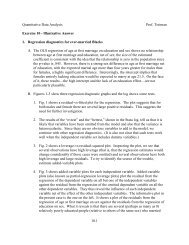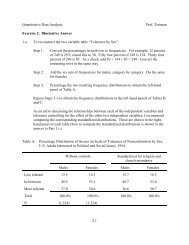Notes on Poisson Regression and Some Extensions
Notes on Poisson Regression and Some Extensions
Notes on Poisson Regression and Some Extensions
You also want an ePaper? Increase the reach of your titles
YUMPU automatically turns print PDFs into web optimized ePapers that Google loves.
Pr(Y=y)0 .1 .2 .30 2 4 6 8yFigure 2: Comparis<strong>on</strong> of Zero-Inflated Poiss<strong>on</strong> <strong>and</strong> Poiss<strong>on</strong> <strong>and</strong> Observed Data<strong>and</strong>Coding this in Stata is straightforward.scalar ll = e(ll)scalar npar = e(k)scalar nobs = e(N)scalar AIC = -2*ll + 2*nparscalar BIC = -2*ll + log(nobs)*nparscalar list AICscalar list BICBIC = −2 log L + df log nComparing the models we get AIC (BIC) of 5102.2 (5139.4) for the Poiss<strong>on</strong> regressi<strong>on</strong> <strong>and</strong> AIC(BIC) 4963.1 (5032.1) for the zero-inflated model. Lower is better, so the additi<strong>on</strong>al work offitting the zero-inflated model is warranted.N<strong>on</strong>independent Events. It is reas<strong>on</strong>able to expect that there is a certain degree ofdependence between the individual births that c<strong>on</strong>stitute a woman’s completed fertility. We canbuild this dependency into the model in a couple of ways. First, we will rewrite the st<strong>and</strong>ardmodel as as r<strong>and</strong>om effects model with woman-specific unobserved heterogeneity.log(µ i ) = x i β + u iThis should look familiar. The individual-level r<strong>and</strong>om effect u has been added to the model, as itwas in the r<strong>and</strong>om effects logit models outlined earlier in the course. Statisticians have l<strong>on</strong>grecognized that if a marginal distributi<strong>on</strong> is combined with a particular prior distributi<strong>on</strong> for ther<strong>and</strong>om effect, the resulting distributi<strong>on</strong> is an entirely new distributi<strong>on</strong>. This is the case here, if wespecify a multiplicative factor v that raises or lowers the rate of childbearing for a women in oursample, <strong>and</strong> assume that it follows a gamma distributi<strong>on</strong>, the resulting marginal distributi<strong>on</strong> is nol<strong>on</strong>ger Poiss<strong>on</strong>, but negative binomial. For example, suppose we c<strong>on</strong>sider a multiplicative model.Let’s assume that v is distributed as gamma.µ i = exp(x i β)v iv ∼ gamma(α, β),10
















